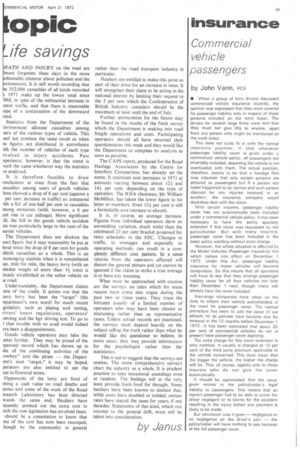OPIC
Page 57

If you've noticed an error in this article please click here to report it so we can fix it.
Ife savings
EATH AND INJURY on the road are most forgotten these days in the more shionable clamour about pollution and the nvironment. It is still worth recording that e 352,086 casualties of all kinds recorded 1971 make up the lowest total since 968, in spite of the substantial increase in aotor traffic, and that there is reasonable Lope of a continuation of the downward rend.
Statistics from the Department of the 7.nvironment allocate casualties among sers of the various types of vehicle. This eed not produce the same result as when le figures are distributed in accordance dth the number of vehicles of each type avolved in injury accidents. Past xperience, however, is that the trend is 'inch the same whichever way the statistics re analysed.
It is therefore feasible to draw onclusions at once from the fact that asualties among users of goods vehicles lone showed a drop of 8 per cent (against a per cent increase in traffic) as compared rith a fall of one-half per cent in casualties mong motorists (with, however, a 6 per ern rise in car mileage). More significant the fall in the goods vehicle accident ite was particularly large in the case of the eavier vehicles.
The Department does not disclose the Kaet figure, but it may reasonably be put at bout twice the drop of 8 per cent for goods ehicle casualties as a whole. This is an acouraging statistic when it is remembered tat, mile for mile, the heavy lorry (with an nladen weight of more than I+ tons) is !ready established as the safest vehicle on le road.
Understandably, the Department claims nme of the credit. It points out that the eavy lorry has been the "target" (the repartment's own word) for much recent gislation, such as plating and testing, rivers' hours regulations, operators' en sing and the hgv driving test. To go to 1 that trouble with no avail would indeed we been a disappointment.
Goods vehicle operators may take the atter further. They may be proud of the aproved record which has shown up in ate of the continuing activities of the :owboy" and the pirate — the Departent's next "target," it may be hoped. perators are also entitled to see the sue in financial terms.
Opponents of the lorry are fond of ming a cash value on road deaths and juries and some of the work of the Road esearch Laboratory has been directed wards the same end. Hauliers have Nuently pointed out the extra cost in lich the new legislation has involved them. should be a consolation to know that me of the cost has now been recouped, .hough by the community in general rather than the road transport industry in particular.
Hauliers are entitled to make this point as part of their drive for an increase in rates. It will strengthen their claim to be acting in the national interest by limiting their request to the 5 per cent which the Confederation of British Industry considers should be the maximum at least until the end of July.
Further ammunition for the future may be found in the results of the fresh survey which the Department is making into road freight operations and costs. Participating operators should all have returned their questionnaires this week and they would like the Department to complete its analysis as soon as possible.
The CAPS report, produced for the Road Haulage Association by the Centre for Interfirm Comparison, has already set the scene. It estimates cost increases in 1971 at amounts varying between about 124and 14+ per cent, depending on the type of operation. The RBA chairman, Mr William McMillan, has taken the lower figure in his letter to members. Even 12+ per cent is still a formidable cost increase to absorb.
It is, of course, an average increase. Figures from individual operators show an astonishing variation, much wider than the celebrated 23 per cent bracket proposed for rates schedules in the EEC. Changes in traffic, in tonnages and especially in operating methods, can result in a completely different cost pattern. In a sense returns from the operators affected will distort the general picture and yet cannot be ignored if the claim to strike a true average is to have any meaning.
What must be approached with caution are the surveys on rates which for some reason have come into vogue during the past two or three years. They trace the fortunes usually of a limited number of operators who may have been chosen as interesting rather than as representative cases. Unless actual records are examined, the surveys must depend heavily on the subject telling the truth rather than what he would like the questioner to believe. In some cases, they may provide information for the psychologist rather then the statistician.
This is not to suggest that the surveys are useless. The more comprehensive surveys chart the industry as a whole. It is prudent practice to take occasional soundings even at random. The findings will at the very least provide fresh food for thought. Some hauliers have been known to declare that, while costs have doubled or trebled, certain rates have stayed the same for years, if not decades, Statements of this kind, which run counter to the general drift, must still be taken into consideration.
by Janus












































































































